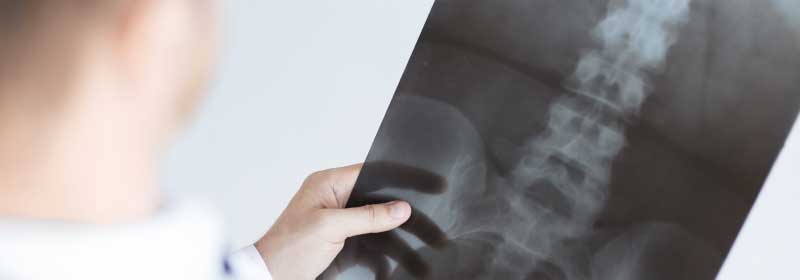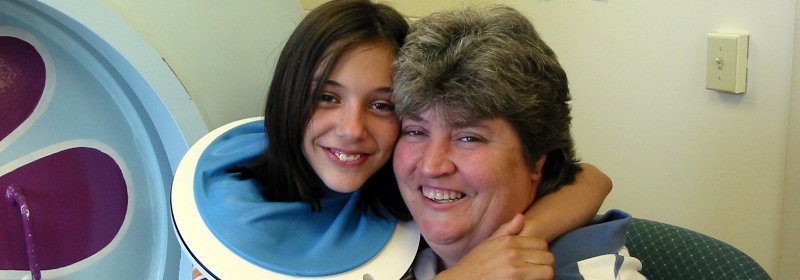Oxygen In. Pain & Surgery Out.
As a high school senior, Val was in a car accident during the winter of 1992. Because she had no visible injuries at the scene, she refused going to the hospital. Unfortunately, the effects of the accident caught up with her quickly and kept her out of school for an entire week as she was unable to sit for long periods of time without severe back and neck pain. Thinking she was just sore, Val never went to see a doctor to get checked out and diagnosed for any possible complications caused by the accident.
After graduating college, Val spent 15 years working as a cosmetologist. Spending long hours on her feet day after day led to severe back pain once again. In 2012, after a busier than usual Christmas season at the salon, Val’s back pain became so intense that she could barely walk for two days. She could shuffle her feet, but couldn’t take steps without excruciating pain in her lower back.
At this point, Val went to see a chiropractor in hopes of determining what could be causing such intense pain. X-rays and tests performed by the chiropractor showed that Val had a host of problems with her back. She had several bone spurs in her lower back, middle back and neck. She also had a severe curve in her neck which suggested that at some point in her life, she had, in fact, experienced whiplash. The biggest problem was that Val had a tremendous amount of inflammation in her lower back as well as a spinal disk that was beginning to degenerate.
The spinal discs in the body act as a strong elastic pivot for each joint segment of the spine, providing stability and allowing a relatively wide range of motion in all directions in the lower back and neck. When a disc begins to degenerate, and lose its strength and pliability, it can cause a range of painful and potentially debilitating symptoms like Val was experiencing.
With the chiropractor’s x-rays and diagnosis in hand, Val went to see her primary care physician to get her opinion. She agreed with the chiropractor’s diagnosis. Both the chiropractor and physician told Val that if she didn’t make some changes in her life, she would be looking at back surgery sooner than later in life. Wanting to avoid back surgery if at all possible, Val decided to do anything she could to avoid it. She started by cutting back her hours at the salon and then began looking into the possibility of finding a different job where she wouldn’t be on her feet as much.
After several appointments with her chiropractor she asked if he had ever heard of Hyperbaric Oxygen Therapy. He told her that he had heard of it but admitted that he didn’t know much about it. Val explained to him the many benefits of HBOT treatments, including its ability to reduce inflammation and swelling. He said that from what he knew about it, it couldn’t hurt and encouraged her to go ahead and give it a try.
Val made the decision to begin daily HBOT treatments in the hopes that it would, at the very least, relieve enough pain to allow her to function. On her first day of treatment, Val was shocked to realize that as soon as the chamber was pressurized, she was no longer pain! She almost cried! It was such a relief to experience even a short break from the constant pain. When that first treatment was over and the chamber was depressurized, she could feel the pain begin to return. However, the relief from the pain she felt during that treatment gave her hope for a life free from back pain.
After five HBOT treatments, Val had an appointment with her chiropractor. She didn’t tell him that she had started treatments because she wanted to see if he noticed a difference. As he was working on her lower back he asked her if she had started hyperbaric treatments. She asked him to tell her why he was asking and then she would answer his question. He informed her that the inflammation he felt in her lower back was at least half of what it had been on her previous appointment. She then informed him that yes, she had just completed her first five treatments. He told her, “It’s working. Keep going!”
By the time Val completed a round of 40 HBOT treatments, she was experiencing virtually no pain. The chiropractor told her that the inflammation in her back was completely gone. She was able to begin walking, jogging and exercising again. She was even able to complete a half marathon in October 2015.
In 2016, Val got a followup x-ray of her lower back which showed no disk degeneration but did show Sacroiliitis (an inflammation of the sacroiliac joints where the lower spine and pelvis connect). Her doctor prescribed physical therapy. Val also decided to do additional HBOT treatments to help reduce the inflammation. With physical therapy and HBOT treatments, Val gained relief from Sacroilitiis. She is now able to maintain her back health with regular chiropractic treatments, stretching, and exercise. Most importantly, Val was able to avoid having a dreaded back surgery.
No matter what you’ve been told, there is hope… for this and many other conditions. HBOT is treatment without drugs… without surgery… without pain.











